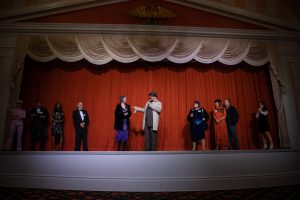In the world of immersive theater, I’ve come to deeply appreciate a principle I’ve termed the “Glass Ceiling of Entertainment Rule.” It’s a guideline that, though it doesn’t often take center stage in our discussions, significantly steers my approach to immersive acting and my interaction with participants.
Think back to those family gatherings and friendly get-togethers from your childhood. The adults always seemed to be having a rollicking good time, much of which hinged on shared histories, inside jokes, and mutual experiences. Despite your best attempts at cracking a joke or pulling a prank, their laughter always seemed richer when it was at something one of them said or did. This, in essence, is the Glass Ceiling of Entertainment Rule.
In immersive theater, we are the children trying to entertain at the adults’ party. We share the stage with the participants’ friends, co-workers, and family. These are relationships woven with threads of shared experiences, private jokes, and personal nuances. As actors, no matter how stellar our performances, we can’t surpass the level of entertainment they derive from each other. We’re up against an invisible barrier, a glass ceiling, if you will.

The beauty of the Glass Ceiling of Entertainment Rule lies in its inherent challenge. It pushes us to devise creative ways to facilitate the participants’ engagement, to become the catalyst that sparks their interactions. In immersive acting, we are not merely performers, but guides helping the participants become the co-creators of their own experience.
As we navigate this unique landscape, the goal shifts away from trying to be the funniest or the most entertaining. Instead, we aim to empower the participants to fuel their own fun and to make them the stars of their story. The real magic happens when they find themselves laughing not at our scripted jokes, but at the situation they’ve created. At that moment, we’ve successfully tapped into their shared histories, inside jokes, and mutual understanding.
Embracing the Glass Ceiling of Entertainment Rule has profoundly shaped my approach to immersive theater. It has encouraged a shift from traditional performance-centered thinking to audience-empowerment. It has fostered an environment where participants feel seen, heard, and entertained on a personal level.
From this vantage point, the glass ceiling doesn’t seem like a barrier at all, but rather a mirror reflecting the participants’ joy back at them. It’s a reminder that in immersive acting, we are not just performers but facilitators of joy, laughter, and unforgettable moments.
As you embark on your immersive event journey, let the Glass Ceiling of Entertainment Rule be a touchstone. If you’re seeking guidance to navigate this unique aspect of immersive acting, I’m here to lend a hand; you can get in touch with me here. Let’s collaboratively create memorable experiences, where the laughter is genuine and every participant emerges as the star of their show.


